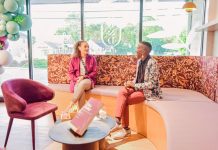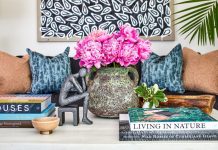Across the street from Mondawmin Mall, at the corner of Liberty Heights Avenue and Reisterstown Road, a band of teenagers is putting art on a wall—in broad daylight, with no spray cans in sight. Instead, they are adding the finishing touches to a mosaic mural, 15-feet-wide and 5-feet-high, a stylized sunrise with rays of gold, coral, pink and scarlet. The words WELCOME TO GREATER MONDAWMIN arch over it, bordered by sparkling rows of mirror tile.
“It’s not just plain Mondawmin anymore,” jokes Darrian Hernandez, 15, smoothing grout between pieces of tile with a float. “It’s Greater Mondawmin now.”
Beside him work five other teens from the neighborhood, all neatly attired in beige T-shirts and belted pants. “You pull up your pants and you pull up your potential,” opines Sage Tarrant, 15. The belts were handed out earlier in the week by D.J. Horrey and Kliffi Blackstone, their counselors at Parks and People, an organization that employs kids through YouthWorks to spruce up the neighborhoods they live in.
The mural itself is a project of Mosaic Makers, a two-woman nonprofit that practices the fine art of piecing things together, whether it’s shards of ceramic tile, odds and ends of grant funding, or broken lives and neighborhoods.
Lauren Siegel and Pam Stein met at Health Care for the Homeless, where both were social workers. While Pam provided art therapy at the organization’s headquarters, Lauren’s work involved going into the streets. “There was a period when Lauren encountered so much trauma,” explains Pam, “so many overdoses, so much abuse and neglect, clients she cared about, dead bodies left for days, that she was just overwhelmed.”
Knowing Lauren was also an artist, Pam invited her to come spend some time working on mosaics in the art shed in her backyard. “Hearts, windmills, guitars, fish, elephants—I made about 60 mosaics in about four months,” says Lauren. “And I felt a little better after each one. It made me think about how art heals things. If it helped me, perhaps it could help other people.”
“She walked out one day and said, ‘We should start a nonprofit,’” continues Pam, who agreed wholeheartedly.
In April 2012, Mosaic Makers debuted with a workshop for the women’s group at Paul’s Place, a soup kitchen in Pigtown. They asked the participants two questions: Has your heart been broken? What fills your heart? Each woman made a mosaic in response and gave a detailed explanation of its meaning. Many of the women spoke about their children, from one stationed in Iraq to one murdered on the street. “The effect on both the individuals and the group as a whole was so clear,” says Pam. “A talk therapy group couldn’t have gotten these stories out in a couple of hours.”
 Since then, Pam and Lauren have taken their buckets of grout, their donated tiles and their come-on-and-try-it attitude to street corners and community centers in dozens of neglected neighborhoods.
Since then, Pam and Lauren have taken their buckets of grout, their donated tiles and their come-on-and-try-it attitude to street corners and community centers in dozens of neglected neighborhoods.
In Cherry Hill, they worked with children who had seen an infant shot and killed in a drive-by to make a memorial—then went on to decorate the local shopping center with ten large mosaics, bringing together institutionalized youth and seniors to collaborate.
At Roberta’s House in East Baltimore, a grief support center, they worked with bereaved families to create memory trees, vision boards and memory bottles. Just down the street in Station North, they got a grant to involve existing community members in the changing neighborhood. Their idea: invite people living atthree homeless centers in the area to create a mural on the wall at North Avenue and Calvert Street.
The current Mondawmin project was made possible by a grant from the Sparkplug Foundation, $5,000 that Mosaic Makers stretched to cover three murals on the west side: one at an elementary school for disabled kids, one at a rec center and this sunrise on the neighborhood’s busiest corner.
The teens, proudly admiring their work at the end of the two-week project, all live in walking distance of the mural and look forward to seeing it every day. “They’re gonna remember us by this,” says Malik Keith, 15. “The colors mean a brighter future.”
“Public art can change the way people feel about the place they live,” says Pam. “And collaborating on that art makes it even more powerful.”
With so many blocks, buildings and open spaces in the city shattered by violence and ugliness, Mosaic Makers has its work cut out for years to come. “The biggest challenge is funding,” says Lauren. “We always make do with what we have, but we could do so much more.”



